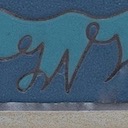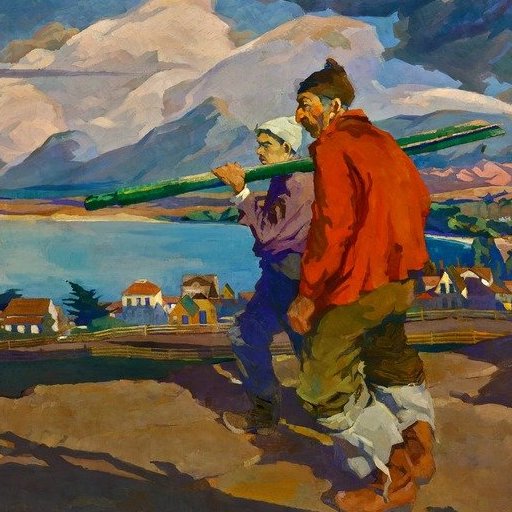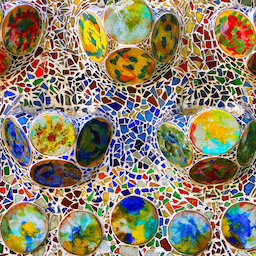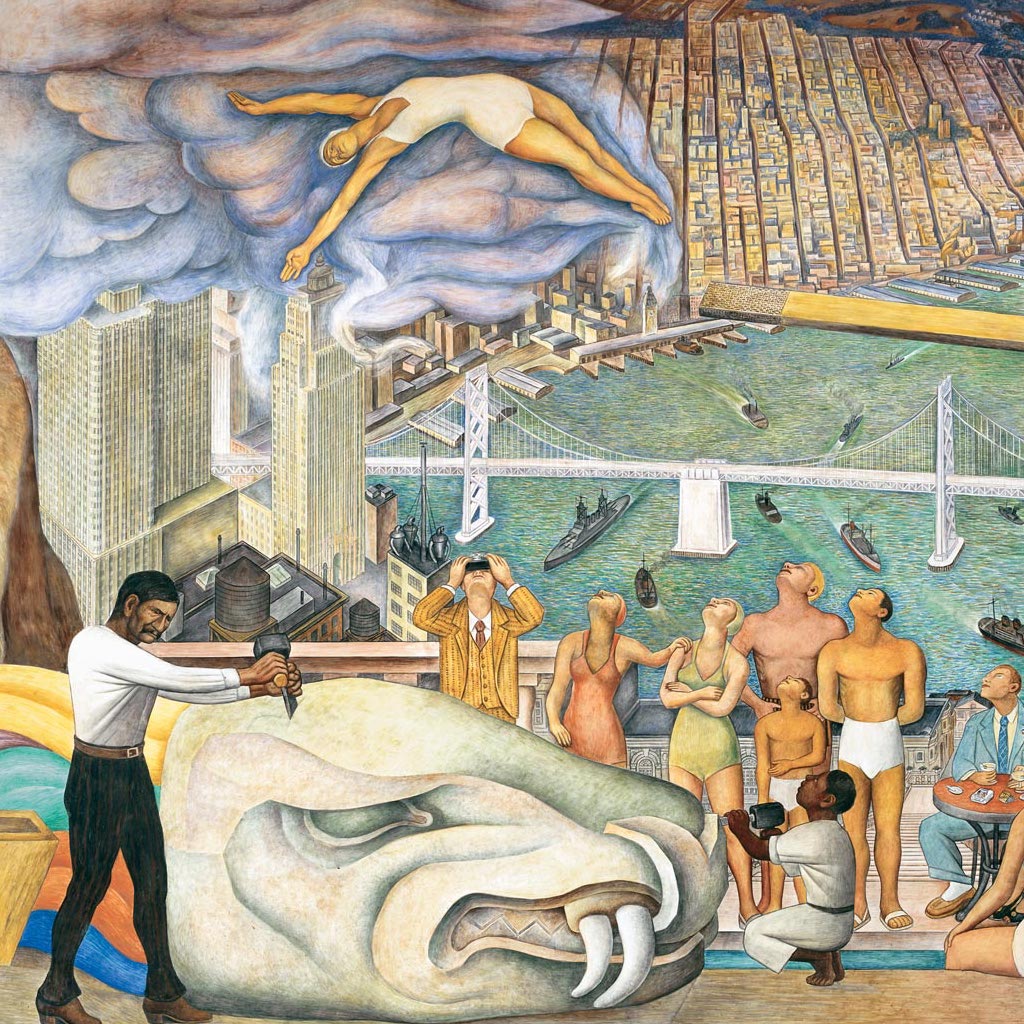The Mural FAQ
-
“...”, from XXX
-
“When was the Monterey Mural created?”
 The Mural was conceived in 1983,
one of a series of art acquisitions for the Conference Center, led by
Peter Coniglio, the mayor of Monterey during its original development.
Maestro Granizo worked on the Mural through 1983 and 1984
— see his dates and initials in the bottom row of tiles.
During this time he also created the larger Olympic Fantasy in Los Angeles.
The Mural was conceived in 1983,
one of a series of art acquisitions for the Conference Center, led by
Peter Coniglio, the mayor of Monterey during its original development.
Maestro Granizo worked on the Mural through 1983 and 1984
— see his dates and initials in the bottom row of tiles.
During this time he also created the larger Olympic Fantasy in Los Angeles.
At the Mural's unveiling on March 27, 1984, Granizo was glad his work was able to include “every type of person: the carefree Indians, merchants, photographers and honky-tonk vendors.” Granizo dedicated his mural to “people I relate to, who don't wear shoes or comb their hair ... to the physically disabled [his left leg is paralyzed — an injury incurred on Utah Beach during the WWII D-Day assault] ... to the Spanish-speaking ... to your citizens ... (and) to people who enjoy life.”
-
“What's missing from the Mural?” or “What places should we visit that aren't depicted?”
Now one of the region's major attractions, the Aquarium opened in 1984 — the same year as the Mural.

Ed “Doc” Ricketts (1897-1948); his BFF, John Steinbeck, has a cameo in the mural (A60). Doc's Lab is tucked neatly into Cannery Row by Granizo and one of Ferrante's fishermen is pointing at the sign (B46-47). Tours of “Doc's Lab” have started again recenently. You can see the Lab's oceanfront, including the old specimen tanks, from the back alley of the Clement Hotel. The Aquarium has a Ricketts exhibit as well.
If only someone had suggested to Granizo to christen one of the boats in the harbor as the Western Flyer! Ricketts and Steinbeck's chartered 1940 voyage on the Flyer to the Gulf of California was popularized in their books.

Ironically, Granizo did not feature any visual artists and there are many to choose from. Many consider Carmel to be the archetypal “artist colony,” but the physical beauty of the Central Coast started drawing artists to Monterey and the Peninsula long before the start of the 20th Century. Visit the Monterey Museum of Art and the many local art galleries to learn and see more.
-
“Is this art best described as a tile mural or mosaic?”
Why choose? Both terms alliterate with “Monterey”!
 A
mosaic
is an assembly of closely spaced poly- or monochrome pieces
of stone, shell, glass, metal, ceramic or other material(s)
— the
tesserae —
embedded in a binder such as mortar or cement.
Considered a historical convergence of art and architecture,
this medium has been used to decorate walls, floors and columns for over five thousand years.
The Catalan architect Antonin Gaudí (1852-1926)
is well known for his
trencadís technique,
using broken or irregular pieces to cover structures and ornamentals.
A
mosaic
is an assembly of closely spaced poly- or monochrome pieces
of stone, shell, glass, metal, ceramic or other material(s)
— the
tesserae —
embedded in a binder such as mortar or cement.
Considered a historical convergence of art and architecture,
this medium has been used to decorate walls, floors and columns for over five thousand years.
The Catalan architect Antonin Gaudí (1852-1926)
is well known for his
trencadís technique,
using broken or irregular pieces to cover structures and ornamentals.
 A
mural
is applied on a wall, ceiling or other permanent surface,
typically by painting either the surface directly, e.g., a
fresco,
or on canvas or other material
which is then attached to the surface;
the marouflage method has been used for millennia.
In the early 20th century,
the term became associated with the Mexican muralism art renaissance,
led by
“Los Tres Grandes”:
José Clemente Orozco, Diego Rivera and David Siqueiros.
This image is a section of Rivera's fresco
Pan American Unity,
created at the
Golden Gate International Exposition in 1940.
A
mural
is applied on a wall, ceiling or other permanent surface,
typically by painting either the surface directly, e.g., a
fresco,
or on canvas or other material
which is then attached to the surface;
the marouflage method has been used for millennia.
In the early 20th century,
the term became associated with the Mexican muralism art renaissance,
led by
“Los Tres Grandes”:
José Clemente Orozco, Diego Rivera and David Siqueiros.
This image is a section of Rivera's fresco
Pan American Unity,
created at the
Golden Gate International Exposition in 1940.
More than one source has used the phrase “mosaic mural.”
-
“How much did the Mural cost?”
Sources have quoted the cost as either $72,000 or $77,000, roughly $190,000 in today's money. A member of the Conference Center Arts Commission said at the unveiling in 1984, “you couldn't tile your shower for this cost [by the square foot].”
The mural renovations in 2009 and 2015 cost $55,000 and $122,000, respectively. The latter required the complete removal, restoration and reinstallation on the back of the new Center. Some of these funds came from the City of Monterey's Neighborhoold and Community Improvement Program (NCIP).
-
“How many scenes or subjects are represented in the Mural?”
We don't know. Granizo famously forswore sketches, planning or other design documentation of his work. As Dennis Copeland remarks, “So many people and events colorfully depicted that some are hidden in plain sight...some deliberately by the artist.” There have been claims of 150 scenes and we hope to eventually describe them all in the Catalog of Subjects.
A good upper bound for the number of subjects is the population of 9-by-12-inch tiles that provide the mural content: 549. There are a few individual tiles with more than one subject, but most subjects cover more than one tile. A good segue to the next question....
-
“How many tiles are in the Mural?”
673, including the 549 9-by-12-inch tiles that make up the content canvas and the border or framing tiles; there are 124 border tiles.
However, this truth is one that must be qualified by a question: “When?” As part of the renovation in the late twenty-teens, a new design for the Mural's anchoring or backing wall required several border tiles to be broken in two. (Perhaps this is one reason some people call it a mosaic?!?) The original installation was widely cited as having 663 tiles.
“What if I didn't find the Mural question or answer I was expecting?”
contact_supportYou can send your questions and answers to montreymural(at)gmail(dot)com.